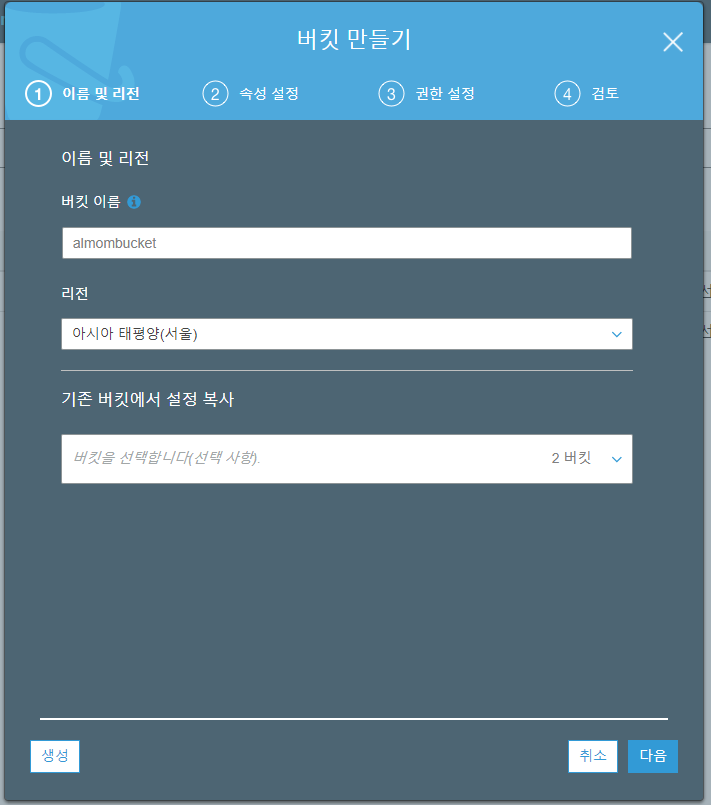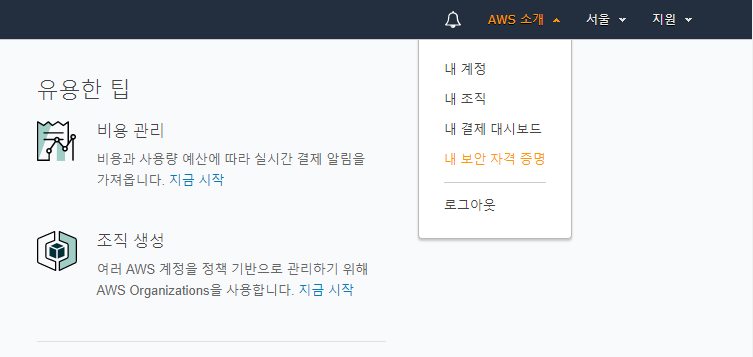2017 - 12 - 28 (목)
AWS S3 이미지 서버 구성 [ 버킷 ]
https://aws.amazon.com/ko/free/?sc_channel=PS&sc_campaign=acquisition_KR&sc_publisher=google&sc_medium=english_cloud_computing_hv_b&sc_content=aws_core_e&sc_detail=aws&sc_category=cloud_computing&sc_segment=188903893174&sc_matchtype=e&sc_country=KR&s_kwcid=AL!4422!3!188903893174!e!!g!!aws&ef_id=Wjp@@gAABb1G2SmL:20171226033303:s
에서 로그인 후 S3 서비스 를 활용하고자 한다. 기존에 RDS 서버는 생성했고 (Mysql 서버) S3 는 이미지 업로딩 서버로 쓸 계획이다.
- https://s3.console.aws.amazon.com/s3/home?region=ap-northeast-2 에서 버킷 만들기 버튼을 클릭한다.
-
위의 사진같은 화면에서 버킷이름은 소문자로 프로젝트이름 + bucket 으로 간단히 정했다.
-
버킷을 만든 후 이미지를 저장해줄 폴더를 생성한다. 기존 로컬에서 만들어논 폴더트리와 동일하게 구성하였다.
ACCESS KEY 발급
-
위의 사진에서 보이는바와 같은 탭에서 엑세스키를 발급받는다.
-
ACCESS KEY ID 를 발급받고 (Access key 및 보안 Access Key) 를 노출안되게 기억해 둔다.
스프링에서 연동하기
- 라이브러리 다운로드 : aws sdk 라이브러리는 지속적으로 업데이트 되므로 알맞은 버전을 사용하도록 하자.
<!-- https://mvnrepository.com/artifact/com.amazonaws/aws-java-sdk -->
<dependency>
<groupId>com.amazonaws</groupId>
<artifactId>aws-java-sdk</artifactId>
<version>1.9.2</version>
</dependency>
- S3Util 구현 : 아마존 서버와 connect 하여 상호작용하기 위한 공통적인 메서드를 생성한다.
package com.almom.util;
import java.io.ByteArrayInputStream;
import java.io.File;
import java.io.FileNotFoundException;
import java.util.List;
import com.amazonaws.ClientConfiguration;
import com.amazonaws.Protocol;
import com.amazonaws.auth.AWSCredentials;
import com.amazonaws.auth.BasicAWSCredentials;
import com.amazonaws.services.s3.AmazonS3;
import com.amazonaws.services.s3.AmazonS3Client;
import com.amazonaws.services.s3.model.Bucket;
import com.amazonaws.services.s3.model.GeneratePresignedUrlRequest;
import com.amazonaws.services.s3.model.ObjectMetadata;
public class S3Util {
private String accessKey = "엑세스키"; // 엑세스 키
private String secretKey = "보안 엑세스키"; // 보안 엑세스 키
private AmazonS3 conn;
public S3Util() {
AWSCredentials credentials = new BasicAWSCredentials(accessKey, secretKey);
ClientConfiguration clientConfig = new ClientConfiguration();
clientConfig.setProtocol(Protocol.HTTP);
this.conn = new AmazonS3Client(credentials, clientConfig);
conn.setEndpoint("s3.ap-northeast-2.amazonaws.com"); // 엔드포인트 설정 [ 아시아 태평양 서울 ]
}
// 버킷 리스트를 가져오는 메서드이다.
public List<Bucket> getBucketList() {
return conn.listBuckets();
}
// 버킷을 생성하는 메서드이다.
public Bucket createBucket(String bucketName) {
return conn.createBucket(bucketName);
}
// 폴더 생성 (폴더는 파일명 뒤에 "/"를 붙여야한다.)
public void createFolder(String bucketName, String folderName) {
conn.putObject(bucketName, folderName + "/", new ByteArrayInputStream(new byte[0]), new ObjectMetadata());
}
// 파일 업로드
public void fileUpload(String bucketName, String fileName, byte[] fileData) throws FileNotFoundException {
String filePath = (fileName).replace(File.separatorChar, '/'); // 파일 구별자를 `/`로 설정(\->/) 이게 기존에 / 였어도 넘어오면서 \로 바뀌는 거같다.
ObjectMetadata metaData = new ObjectMetadata();
metaData.setContentLength(fileData.length); //메타데이터 설정 -->원래는 128kB까지 업로드 가능했으나 파일크기만큼 버퍼를 설정시켰다.
ByteArrayInputStream byteArrayInputStream = new ByteArrayInputStream(fileData); //파일 넣음
conn.putObject(bucketName, filePath, byteArrayInputStream, metaData);
}
// 파일 삭제
public void fileDelete(String bucketName, String fileName) {
String imgName = (fileName).replace(File.separatorChar, '/');
conn.deleteObject(bucketName, imgName);
System.out.println("삭제성공");
}
// 파일 URL
public String getFileURL(String bucketName, String fileName) {
System.out.println("넘어오는 파일명 : "+fileName);
String imgName = (fileName).replace(File.separatorChar, '/');
return conn.generatePresignedUrl(new GeneratePresignedUrlRequest(bucketName, imgName)).toString();
}
}
- UploadFileUtils 생성 : 직접적으로 S3Util 의 메서드를 사용하는 클래스이다.
package com.almom.util;
import java.io.File;
import java.text.DecimalFormat;
import java.util.Calendar;
import java.util.UUID;
import org.slf4j.Logger;
import org.slf4j.LoggerFactory;
public class UploadFileUtils {
private static final Logger logger = LoggerFactory.getLogger(UploadFileUtils.class);
public static String uploadFile(String uploadPath, String originalName, byte[] byteData) throws Exception {
S3Util s3 = new S3Util();
String bucketName = "almombucket";
//랜덤의 uid 를 만들어준다.
UUID uid = UUID.randomUUID();
//savedName : 570d570a-7af1-4afe-8ed5-391d660084b7_g.JPG 같은 형식으로 만들어준다.
String savedName = "/"+uid.toString() + "_" + originalName;
logger.info("업로드 경로 : "+uploadPath);
//\2017\12\27 같은 형태로 저장해준다.
String savedPath = calcPath(uploadPath);
String uploadedFileName = null;
uploadedFileName = (savedPath + savedName).replace(File.separatorChar, '/');
//S3Util 의 fileUpload 메서드로 파일을 업로드한다.
s3.fileUpload(bucketName, uploadPath+uploadedFileName, byteData);
logger.info(uploadedFileName);
// s3.fileUpload(bucketName, new File(fileName))
return uploadedFileName;
}
private static String calcPath(String uploadPath) {
Calendar cal = Calendar.getInstance();
String yearPath = File.separator + cal.get(Calendar.YEAR);
String monthPath = yearPath + File.separator + new DecimalFormat("00").format(cal.get(Calendar.MONTH) + 1);
String datePath = monthPath + File.separator + new DecimalFormat("00").format(cal.get(Calendar.DATE));
makeDir(uploadPath, yearPath, monthPath, datePath);
logger.info(datePath);
return datePath;
}
private static void makeDir(String uploadPath, String... paths) {
if (new File(paths[paths.length - 1]).exists()) {
return;
}
for (String path : paths) {
File dirPath = new File(uploadPath + path);
if (!dirPath.exists()) {
dirPath.mkdir();
}
}
}
}
- UploadController : 클라이언트 단에서 요청을 받는 컨트롤러로 UploadFileUtils에서 정의한 메서드를 사용하는 부분이다.
@Controller
public class UploadController {
private static final Logger logger = LoggerFactory.getLogger(UploadController.class);
@Inject
private ImageService service;
S3Util s3 = new S3Util();
String bucketName = "almombucket";
@Inject
private UserService userService;
//자격증 & 신분증 이미지 업로드
@ResponseBody
@RequestMapping(value = "/uploadAjaxCert", method = RequestMethod.POST, produces = "text/plain;charset=UTF-8")
public String uploadAjaxCertificate(MultipartFile file) throws Exception {
logger.info("자격증");
logger.info("originalName: " + file.getOriginalFilename());
String uploadpath = "almom/certificate";
ResponseEntity<String> img_path = new ResponseEntity<>(
UploadFileUtils.uploadFile(uploadpath, file.getOriginalFilename(), file.getBytes()),
HttpStatus.CREATED);
String certificatePath = (String) img_path.getBody();
return certificatePath;
}
//커버이미지 업로드
@ResponseBody
@RequestMapping(value = "/uploadAjaxCover", method = RequestMethod.POST, produces = "text/plain;charset=UTF-8")
public String uploadAjaxCoverImg(MultipartFile file) throws Exception {
logger.info("커버이미지");
logger.info("originalName: " + file.getOriginalFilename());
String uploadpath = "almom/coverImage";
ResponseEntity<String> img_path = new ResponseEntity<>(
UploadFileUtils.uploadFile(uploadpath, file.getOriginalFilename(), file.getBytes()),
HttpStatus.CREATED);
String coverImagePath = (String) img_path.getBody();
return coverImagePath;
}
// 프로필 이미지 업로드
@ResponseBody
@RequestMapping(value = "/uploadAjax", method = RequestMethod.POST, produces = "text/plain;charset=UTF-8")
public String uploadAjax(MultipartFile file, String str, HttpSession session, HttpServletRequest request,
Model model) throws Exception {
logger.info("originalName: " + file.getOriginalFilename());
//프로필 이미지의 추가경로
String uploadpath = "almom/profileImage";
ResponseEntity<String> img_path = new ResponseEntity<>(
UploadFileUtils.uploadFile(uploadpath, file.getOriginalFilename(), file.getBytes()),
HttpStatus.CREATED);
String user_imgPath = (String) img_path.getBody();
logger.info(user_imgPath);
UserVO vo = new UserVO();
vo.setUser_profileImagePath(user_imgPath);
UserVO userSession = (UserVO) session.getAttribute("login");
vo.setUser_id(userSession.getUser_id());
logger.info("file name : " + user_imgPath);
userService.uploadImg(vo);
userSession.setUser_profileImagePath(user_imgPath);
session.setAttribute("login", userSession);
logger.info(user_imgPath);
return user_imgPath;
}
//프로필 이미지
@SuppressWarnings("resource")
@ResponseBody
@RequestMapping("/displayFile")
public ResponseEntity<byte[]> displayFile(String fileName, String directory) throws Exception {
logger.info(directory);
InputStream in = null;
ResponseEntity<byte[]> entity = null;
HttpURLConnection uCon = null;
logger.info("FILE NAME: " + fileName);
String inputDirectory = null;
if(directory.equals("profile")) {
inputDirectory = "almom/profileImage";
}
else if(directory.equals("certificate")) {
inputDirectory = "almom/certificate";
}else {
inputDirectory = "almom/coverImage";
}
try {
HttpHeaders headers = new HttpHeaders();
URL url;
try {
url = new URL(s3.getFileURL(bucketName, inputDirectory+fileName));
uCon = (HttpURLConnection) url.openConnection();
in = uCon.getInputStream(); // 이미지를 불러옴
} catch (Exception e) {
url = new URL(s3.getFileURL(bucketName, "default.jpg"));
uCon = (HttpURLConnection) url.openConnection();
in = uCon.getInputStream();
}
entity = new ResponseEntity<byte[]>(IOUtils.toByteArray(in), headers, HttpStatus.CREATED);
} catch (Exception e) {
e.printStackTrace();
entity = new ResponseEntity<byte[]>(HttpStatus.BAD_REQUEST);
} finally {
in.close();
}
return entity;
}
@ResponseBody
@RequestMapping(value = "/deleteFile", method = RequestMethod.POST)
public ResponseEntity<String> deleteFile(String fileName, String directory)throws Exception {
logger.info("delete file: " + fileName);
logger.info("delete foloder:"+directory);
String inputDirectory = null;
if(directory.equals("profile")) {
inputDirectory = "almom/profileImage";
}
else if(directory.equals("certificate")) {
inputDirectory = "almom/certificate";
}else {
inputDirectory = "almom/coverImage";
}
URL url;
HttpURLConnection uCon = null;
try {
s3.fileDelete(bucketName, inputDirectory+fileName);
} catch (Exception e) {
// s3.fileDelete(bucketName, "s_user.jpg");
e.printStackTrace();
}
new File(inputDirectory + fileName.replace('/', File.separatorChar)).delete();
return new ResponseEntity<String>("deleted", HttpStatus.OK);
}
@ResponseBody
@RequestMapping(value = "/deleteFileDB", method = RequestMethod.POST)
public ResponseEntity<String> deleteFileDB(String fileName, String directory)throws Exception {
logger.info("delete file: " + fileName);
logger.info("delete foloder:"+directory);
String inputDirectory = null;
if(directory.equals("profile")) {
inputDirectory = "almom/profileImage";
}
else if(directory.equals("certificate")) {
inputDirectory = "almom/certificate";
}else {
inputDirectory = "almom/coverImage";
}
URL url;
HttpURLConnection uCon = null;
try {
s3.fileDelete(bucketName, inputDirectory+fileName);
} catch (Exception e) {
// s3.fileDelete(bucketName, "s_user.jpg");
e.printStackTrace();
}
service.deleteImage(fileName);
new File(inputDirectory + fileName.replace('/', File.separatorChar)).delete();
return new ResponseEntity<String>("deleted", HttpStatus.OK);
}
}
프론트단에서 이미지 디스플레이하기
<img id="profileImg" class="img-fluid" src="/displayFile?fileName=${userImage}&directory=profile">

